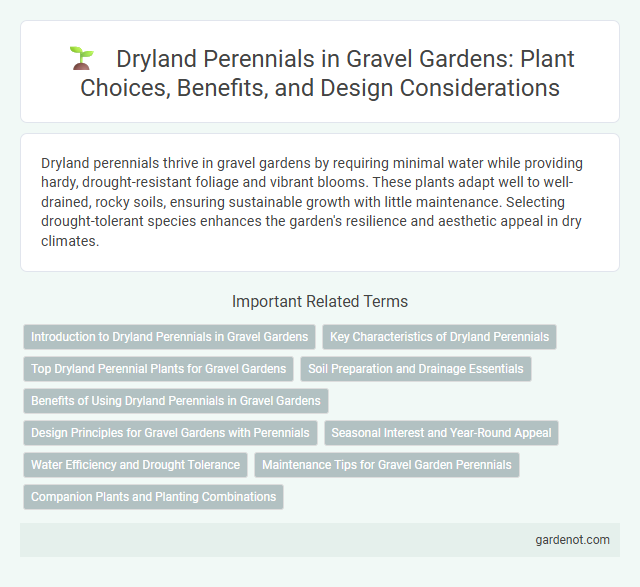Dryland perennials thrive in gravel gardens by requiring minimal water while providing hardy, drought-resistant foliage and vibrant blooms. These plants adapt well to well-drained, rocky soils, ensuring sustainable growth with little maintenance. Selecting drought-tolerant species enhances the garden's resilience and aesthetic appeal in dry climates.
Introduction to Dryland Perennials in Gravel Gardens
Dryland perennials thrive in gravel gardens by adapting to low-water, well-drained conditions that mimic arid environments. These hardy plants, including species like Sedum, Echinacea, and lavender, improve soil stability and biodiversity while requiring minimal irrigation. Their drought resistance and deep root systems make them ideal for sustainable landscaping in dry, rocky soils.
Key Characteristics of Dryland Perennials
Dryland perennials thrive in arid environments due to their deep root systems and drought-resistant foliage, which optimize water absorption and retention. These plants typically exhibit slow growth rates, reduced leaf surface area, and thick, waxy coatings to minimize transpiration. Adapted to nutrient-poor soils, dryland perennials contribute to erosion control and require minimal irrigation, making them ideal for sustainable gravel garden landscapes.
Top Dryland Perennial Plants for Gravel Gardens
Top dryland perennial plants for gravel gardens include lavender (Lavandula angustifolia), which thrives in well-drained, sandy soils and attracts pollinators. Sedum species, such as Sedum spurium and Sedum reflexum, offer drought tolerance and vibrant foliage that complements gravel textures. Other notable options are Russian sage (Perovskia atriplicifolia) and yarrow (Achillea millefolium), both providing resilience and colorful blooms year-round in arid conditions.
Soil Preparation and Drainage Essentials
Dryland perennials thrive in gravel gardens by requiring well-drained, sandy or gritty soil that mimics their natural arid habitats. Enhancing soil preparation with coarse sand, gravel, or organic matter improves aeration and prevents waterlogging, essential for root health and drought tolerance. Proper grading and installation of drainage layers ensure excess water drains quickly, maintaining optimal moisture levels for sustainable dryland perennial growth.
Benefits of Using Dryland Perennials in Gravel Gardens
Dryland perennials thrive in gravel gardens by requiring minimal water, reducing irrigation needs and conserving resources. Their deep root systems improve soil structure and prevent erosion, enhancing garden sustainability. These plants also support drought-resistant biodiversity, attracting pollinators while maintaining vibrant, low-maintenance landscapes.
Design Principles for Gravel Gardens with Perennials
Dryland perennials thrive in gravel gardens by requiring minimal water and adapting well to nutrient-poor soils. Effective design principles include selecting drought-tolerant species such as lavender, sedum, and echinacea, optimizing plant spacing to prevent overcrowding and ensure airflow, and incorporating organic mulch to conserve moisture. Strategic layering of perennials with varying heights and textures enhances visual interest while supporting water efficiency and soil health.
Seasonal Interest and Year-Round Appeal
Dryland perennials in a gravel garden offer vibrant seasonal interest through their varied foliage colors, textures, and blooming patterns that change with the seasons. These drought-tolerant plants maintain structural integrity and aesthetic appeal throughout the year, ensuring continuous visual impact even during dry or cold months. Species like Sedum, Lavender, and Salvia thrive in well-drained conditions, providing both resilience and multi-seasonal charm.
Water Efficiency and Drought Tolerance
Dryland perennials thrive in gravel gardens by exhibiting exceptional water efficiency and drought tolerance, reducing irrigation needs significantly. These plants typically have deep root systems and waxy foliage that minimize water loss and maximize moisture retention in arid conditions. Incorporating species such as lavender, sedum, and yucca enhances garden sustainability while maintaining vibrant seasonal interest.
Maintenance Tips for Gravel Garden Perennials
Dryland perennials in gravel gardens thrive with minimal watering, requiring deep but infrequent irrigation to promote drought resistance. Regularly remove weeds to reduce competition for nutrients and maintain soil aeration. Applying a thin layer of gravel mulch helps retain moisture, prevent erosion, and suppress weed growth for optimal plant health.
Companion Plants and Planting Combinations
Dryland perennials such as Sedum, Echinacea, and Artemisia thrive in gravel gardens due to their drought tolerance and low maintenance requirements. Companion plants like lavender and ornamental grasses enhance soil stability and visual appeal while supporting pollinators. Combining these species creates a resilient ecosystem that conserves water and promotes biodiversity in arid landscaping.
Dryland perennial Infographic

 gardenot.com
gardenot.com